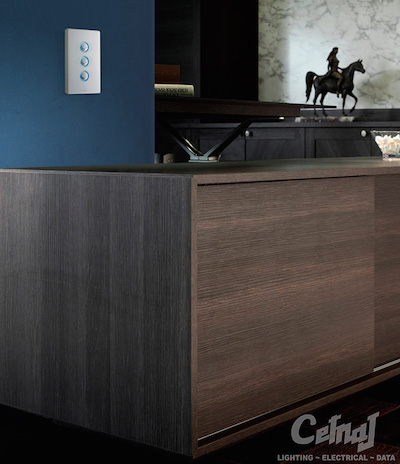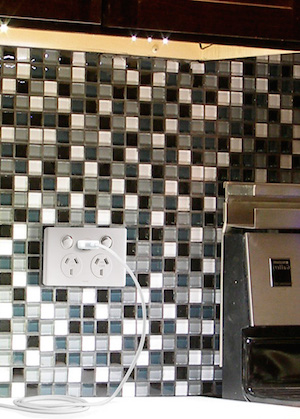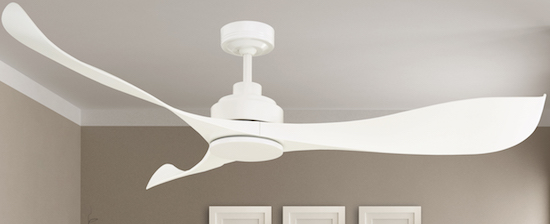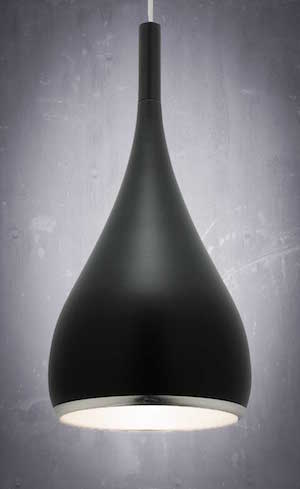How to clean and care for the electrics in your home
Lighting, fans, heaters, and anything else electrical in your home needs looking after the same as any other part of your house. Keeping electrical items clean can be hard, considering how often you touch light switches and how much dust collects on a fan, but it needs to be done carefully as there is electricity involved.
Cleaning your electrical items is important to keep them in good working order, as well as keeping them looking good in your home. We’ve put together a bit of a guide for how to clean and care for the most common electrics in your home.
The first and most important point to note is that it is best and safest to actually turn off the electricity to the house before doing any cleaning work with electrics. Switch off the mains power before undertaking any of the following cleaning tasks.

Light Switches
These can get very dirty and grimy simple from touching them so many times a day - and your hands don’t need to be very dirty for that layer of filth to add up! These are fairly easy and simple to clean, so you can do all of the switches in your house in the one cleaning session.
Step 1: Make sure there is no power going to the switch by turning it on - if the light it corresponds to doesn’t turn on, you’re safe to continue.
Step 2: Dampen the cloth you will use with some water - DO NOT have it dripping with water, it only needs to be slightly damp.
Step 3: Spray whatever cleaning liquid you use (spray and wipe, homemade cleaner, etc.) onto the cloth - NOT directly onto the switch.
Step 4: Gently rub off any dirt, dust, or grime from the plate. Alternatively, if your plate has a cover, you can remove the cover only and wash it thoroughly with soapy water - this would only be necessary for truly filthy switches.
Step 5: Use a cotton tip very lightly dampened with cleaner to clean the switch itself and the little nooks and crannies around. DO NOT poke the cotton tip anywhere but the outside of the switch - you don’t want to leave any liquid inside the switch.
Step 6: Buff the switch and plate dry with another clean cloth. Alternatively, thoroughly dry the plate cover you had taken off the wall and replace it back on the plate.
Turn the power back on only after everything is 100% dry.

Powerpoints
These will get similarly dirty to light switches, though you wouldn’t touch all of the powerpoints in your house as much as the light switches. The method for cleaning powerpoints is largely the same as cleaning light switches, too.
Step 1: Double check there is no power by plugging in a small appliances like a fan and seeing if it goes when you flick the switch. If not, you’re set to go.
Step 2: Dampen a cloth (or use the same one as the light switches), but make sure it is not dripping at all.
Step 3: Spray cleaner onto the cloth, NOT directly onto the powerpoint.
Step 4: Rub any dirt or grime off the plate, careful not to get any water in the holes. Alternatively, if the plate has a cover, you can remove the cover only and wash in soapy water.
Step 5: Use a cotton tip to clean any dust out of the holes - but don’t stick them all the way into the holes, just wipe the outer parts.
Step 6: Buff the powerpoint dry with a different cloth, or thoroughly dry the plate cover before putting it back on.
Turn the power back on only after everything is 100% dry.
Ceiling Fans
This cleaning job can get a bit messy if you’re not careful, so it’s best to take precautions to minimise clean-up after. Otherwise, keeping your ceiling fans clean isn’t too big a task, especially if you do some upkeep regularly.
Step 1: Ensure that the fan cannot be turned on while you are cleaning it - either turn off the power in your house, or make sure everyone that may be home knows not to touch the fan switch.
Step 2: Place a drop sheet on the floor beneath the fan, and over any furniture nearby so the dust doesn’t float down and create more mess.
Step 3: Use a pillowcase to scrape the majority of the dust off the fan blades - put the pillowcase over the blade and scrape the dust down into the pillowcase so it minimises mess again.
Step 4: Wipe the blade with a cloth and cleaning product to get any remaining dust and dirt off - be prepared for it to be really gross if you haven’t cleaned your fan in a while!
Step 5: Repeat steps 3 and 4 for all the blades.
Step 6: Use a small attachment on your vacuum cleaner and vacuum out any dust from inside the motor - from the holes near the blades. If you can, move the motor case to get better access. A can of compressed air will work to blow the dust out if your vacuum won’t work.
Step 7: Clear the loose dust out of the pillowcase into the bin, and through that along with the drop sheets into the wash. Then stand back and enjoy your shiny, clean fan!

Light Bulbs
As well as the fixtures around them, your light bulbs will need cleaning on occasion to make sure they are working to the best of their ability. A dusty or dirty light bulb will not put out as much light - because the light will need to get through the dirt and dust layer before illuminating the space. It especially important with light bulbs that you do not use excessive water and be careful not to break them while cleaning.
Step 1: Ensure the power is off by flicking the light switch and seeing if it turns on. If not, you can proceed, if it turns on, double check the power is off for that part of the house.
Step 2: Wait until the bulb is completely cool (if it had been on before you decided to clean). Once cool, take it out of the fixture.
Step 3: Slightly dampen a cloth - ensure it doesn’t drip at all - and wipe the glass part of the bulb. No water should go anywhere near the metal part or inside the bulb.
Step 4: Wipe the metal part with a dry cloth, and dry the glass part if any water residue is still there.
Step 5: Put it back into the fixture once everything is completely dry, and turn the power back on.
Light Fixtures
With all the different types of light fixtures you can get, the ways to clean them will vary a lot. You might have a chandelier, pendant light, oyster light, lamp, or downlight - or all of them! We’ve got some tips to clean each different type, so read on to find advice on your particular fixtures. A good tip is to dust your fixtures every week or so to minimise the need to fully clean them as often - and make it easier to do when you do clean them. A lamb’s wool duster works well on soft materials, and your regular dusting device will work for hard materials.
Chandeliers
It is best to dust these every week or so, then clean them properly a couple of times a year - regular dusting will make the cleaning process a lot easier.
Step 1: Test that the light doesn’t have electricity running into by flicking the switch once the power is off.
Step 2: If the fixture is not overly large, take it down from the ceiling. If it is very large, find a ladder to reach it with.
Step 3: Wipe all the individual pieces with a cloth dampened with a cleaning solution. This can take a while if your fixture has lots of pieces, and take care to remember what parts you’ve done.
Step 4: Buff dry as you go to make the pieces shine.

Glass/Plastic/Metal Fixtures or Shades
These can be oyster lights, other flush-mounted lights, pendant lights, table lamps, or anything else that is glass, plastic, or metal.
Step 1: Double check there is no power in the light by flicking the switch.
Step 2: Take off the fixture and wash it in soapy water - some oyster lights or other flush-mounted lights can have lots of dirt and even bugs trapped in them. You can leave pendant lights hanging and just wipe them clean if that works. Do not put any light fixture in a dishwasher.
Step 3: Buff dry once clean - ensure no water remains before putting it back on the ceiling/wall.
Fabric Fixtures or Shades
Step 1: Taking the fixture off it makes it easier, but can be left on.
Step 2: Vacuum with a soft brush attachment. If it is still dirty, you may need to take it to a professional for a more thorough clean.
Paper Fixtures or Shades
Step 1: Either take off or leave on to clean.
Step 2: Wipe gently with a dry cloth. Sometimes replacing the shade can be easier than cleaning it.
Rattan Fixtures or Shades
Step 1: Remove if easier, or leave on.
Step 2: Vacuum with a soft brush attachment.
Silk Fixtures or Shades
Step 1: Remove the fixture/shade.
Step 2: Take it to a professional, as silk is easy to damage when cleaning.
Heaters
Keeping heaters clean is important - the best time to clean them is just before you start using them regularly, then again after heating season is over. If your heater filters or vents are clogged with dust, they won’t be working very efficiently - and if you have allergies, all that dust can set you off. Here’s how to keep the key elements of your heater clean.
Filters
Step 1: Make sure the heater is switched off, and the power is off.
Step 2: Carefully remove the filter and either wash all the dust and dirt off in the sink if you have one large enough, or you can hose it in the yard.
Step 3: Ensure the filter is 100% dry before putting it back into place. These can take a while to dry, so be careful that you’ve given it long enough.
Vents
Step 1: Dust the outside of the vent before taking off the cover.
Step 2: Remove the vent cover carefully and remove any larger pieces or dirt or dust.
Step 3: Vacuum the duct with a brush attachment or crevice attachment.
Step 4: Replace the vent cover and vacuum up any residual dust or dirt from the area.
Entire heating system
Hire a professional once or twice a year, depending on your need, to fully clean the whole system. This will ensure everything is always in good working order, and will remove any dust or dirt that you cannot access yourself while cleaning.
You can wipe down the heating unit itself with a slightly dampened cloth whenever necessary.
Air Conditioner
In a similar way to your heater, the air conditioner will work better and more efficiently when kept clean and free of dust. If you have allergies, the dust trapped in air conditioning units can affect you too - so keeping them clean is a win-win for your power bill and your health.
Filters
Step 1: Make sure the system is turned off, and the power for good measure.
Step 2: Take out the filters either wash, vacuum, or brush the dust and dirt off the filter.
Step 3: Ensure it is fully dry (if water was used) before putting it back into the unit.
Entire cooling system
You can wipe down the unit with a slightly dampened cloth when you need to, but everything else ought to to be cleaned by a professional to save the risk of damaging anything. A professional clean is useful once or twice a year, similar to your heater.


